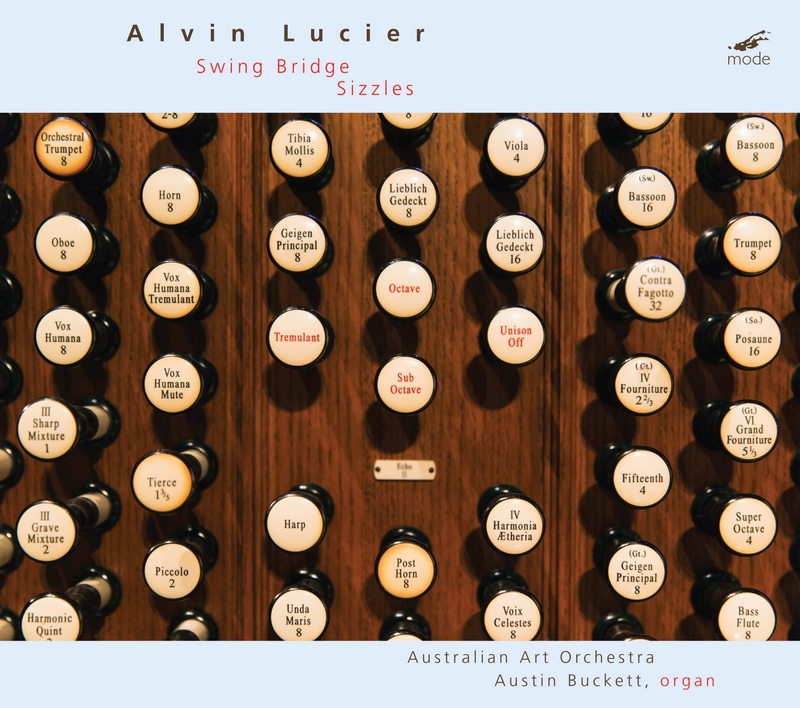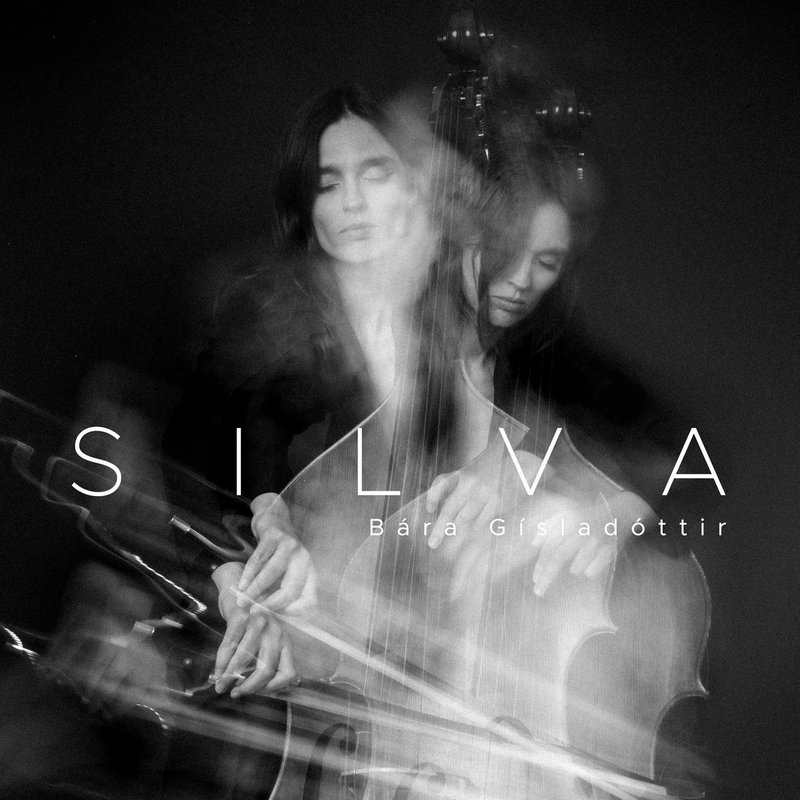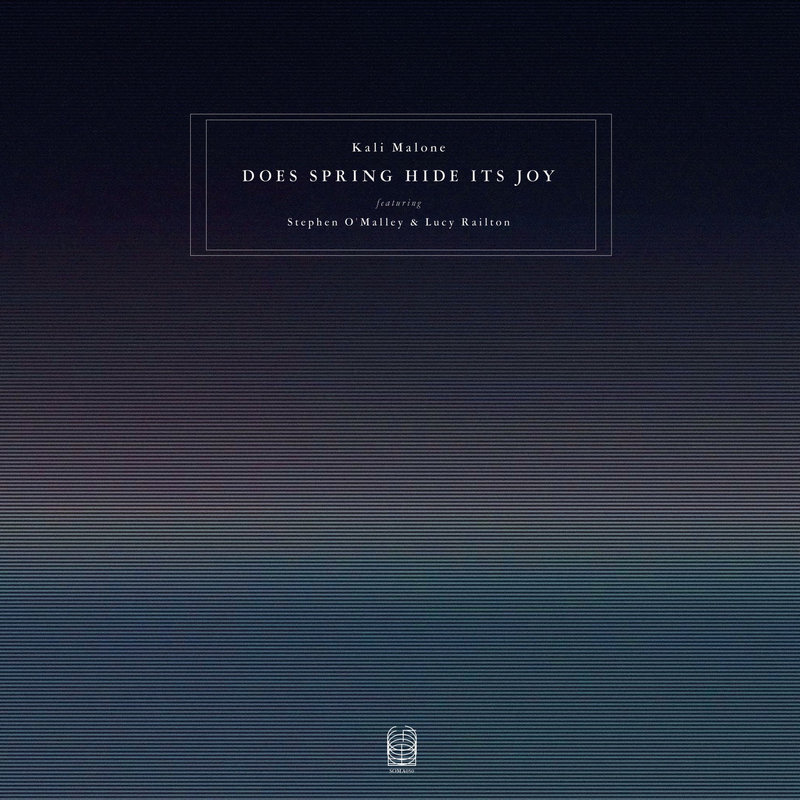It’s been interesting to compare and contrast three recent releases all of which feature drone at the core of their musical language. (The music is long, so i’m going to keep this quite short.) Drone music tends to operate in one of two ways: either by establishing a literal fundamental, i.e. a fixed pitch, against which a varying stream of other elements creates varying degrees of friction, or by making the notion of drone a behavioural fundamental, resulting in slow-moving sound objects in which “the drone” is a roaming, ever-changing focal point. Both of these approaches overlap strongly with the world of ambient music, and as such the ‘interesting’ / ‘ignorable’ duality often becomes relevant, tilting between active and passive levels of listener engagement.

Music that tilts too far away from the interesting end of that continuum can be heard in two drone works by Alvin Lucier, featured on Swing Bridge / Sizzles, a new release on CD and download from Mode Records. Performed by organist Austin Buckett, of the Australian Art Orchestra, on the Melbourne Town Hall Grand Organ, both of these pieces exhibit a problematically aloof level of ignorability. Sizzles is all the more disappointing because of how excitingly it begins: a deep bass throb, just ticking over, before ramping up to an intense juddering. The piece is articulated by drums placed around the performance space, each covered in assorted objects – Lucier suggests “lentils, chickpeas, and candy hearts” – that rattle as the drumheads vibrate. i wonder if this piece (like most pieces) works better if one’s actually present in the space, able to move around these drums, and thereby alter the perspective of its composite timbre. As it is, in this recording, once Buckett opens things up a few minutes in, the remaining nine minutes are a largely undifferentiated sequence of motoric, machine-like clatter that very quickly becomes dull and uninteresting. The album optimistically includes a second performance of the piece (“Take 6”, no less) as a bonus track. It fares no better: again the tantalising uncanny opening, again the subsequent bland chuntering, like a machine gun crossed with a hydraulic digger. Turning up the volume doesn’t help; organs are hard to capture at the best of times, and this one just sounds strangely attenuated no matter how high the dial is turned.
Swing Bridge, a work for organ, ensemble and “pipe wavers” (a phrase i’m assuming is literal), is almost three times as long as Sizzles, and just a little more engaging. Here the focus is on close proximity pitches that glance and impinge against each other, resulting in an ever-changing soundscape of pitch shimmer where the ear continually struggles to resolve both what’s most prominent as well as everything that’s actually present. However, once this basic premise has been set up, the piece meanders around this moderately high register for the remaining half an hour, occasionally intensifying as the clusters become denser, relaxing as they reduce or come closer to frequency alignment. If this had been kept to the same duration as Sizzles it would have felt more hypnotic, but at 36 minutes it exhausts its possibilities long before this time has elapsed. Lucier’s output is hit and miss at the best of times, but these are definitely two of his more glaring misses.

Icelandic composer Bára Gísladóttir‘s approach to drone usually emanates from her double bass, as it does on her latest album SILVA. i was treated to a preview of SILVA back in January, at the Dark Music Days festival. Then i was impressed, but came away with two reservations: did the piece justify its almost hour-long duration? and for how much longer could Bára keep ploughing this particular furrow? As it turns out, spending time with SILVA has allayed both of those concerns, being as it is a work that demonstrates superb control of activity and passivity, together with a telling sense of perspective, in terms of both near and far as well as left to right across the stereo field.
It’s a piece that falls broadly into four sections, the first of which – at 25 minutes, the longest – establishes the essence of the work’s behaviour and language. It’s a tactile music, the close, intimate, acoustic sounds from the bass mingling with and expanded by the electronics. Repeating loops regularly appear, as does a lurking fuzzbuzz at the periphery, the latter forming an essential part of the complex grain of the music. There are times when SILVA enters brief periods of repose, reducing to a quasi-“rest” state where a soft, high perfect 5th/minor 6th is revealed like a floating omnipresence otherwise inaudible, and there are also times when Bára’s bass tentatively begins the familiar wavering form of song captured in her previous work.
The second section takes this nascent song and allows it to emerge more fully, initially like glinting light but becoming squally and intense. Almost everything around the bass falls away, in a mesmerising sequence that reveals how narrow and exposed the music has become at this point. It’s almost painfully immediate. The third section (starting around 35 minutes in) returns to the soundworld of the first, though at times interestingly caught between drifting and momentum, in part caused by rhythmic tappings that appear. The bass manages to protrude at times, injecting fragile harmonics into the throb and fuzz. The final section (~45 minutes in) goes even further than the second, pulling everything back to the point where it has almost died away. A floating oscillating tone is all that remains, with traces of faint wind at the fringes. The most gentle of bass presences slowly materialises into a subtle rumble, and the work concludes as a highish drone on a bed of barely growling bass and noise, the wind kept at a distance.
Bára Gísladóttir’s ability to take a relatively simple palette of timbres and ideas and weave such an extensive, ever-changing tapestry as this is genuinely masterful. That really shouldn’t come as a surprise by this stage, but SILVA is breathtaking nonetheless, and the way it allows the listener space to connect and disengage through its undulating narrative only makes the experience more compelling.
SILVA is available on CD (released by ESP-Disk’) and download (released by Sono Luminus).

i said that, because the music is long, i was going to keep this short, but it’s hard to do that when considering the latest album from Kali Malone. While her previous release, Living Torch, was more intriguing than genuinely impressive, Does Spring Hide Its Joy is among the most – and might just be the most – compelling music i’ve yet heard in 2023. It presents itself three times, with each one-hour rendition of the piece teasing out more details, while hinting at a never-ending range of possibilities that could emerge. This is essentially behavioural drone rather than literal, where pitches materialise, sustain and move or vanish, causing a continual reappraisal of the work’s overall harmonic and timbral implications. As with SILVA, this is complicated further due to its mingling of acoustic (Stephen O’Malley’s electric guitar and Lucy Railton’s cello) and electronic (performed by Malone).
One of the work’s most engaging properties – also subject to continual change, sometimes suddenly – is its perceived stability. There are times when everything about Does Spring Hide Its Joy seems measured and controlled, yet this is consistently undermined by yawning abysses that open up and tectonic quakes caused by deep bass judder. Real and imaginary cadences appear, their resolutions rippling in gentle shimmer; real and imaginary details materialise on the music’s surface, often due to apparent shifts in the music’s chiaroscuro, tilting between darkness and light. Likewise, despite often displaying a triadic quality, its steady forward motion regularly passes through extended sequences that sound entirely provisional, some of which could seemingly continue suspended indefinitely, while others evidently need to move on toward something more certain.
Notions of triads and fundamentals are ultimately undermined by the music’s rethinking (rejection?) of tonality. There’s the impression that all pitches in all registers are independent – not at odds with each other but part of a disparate, large-scale mobile where relationships are incidental, even accidental, rather than being necessarily part of a preordained underlying unity. There’s no hierarchy at all, apart from what we impose on it ourselves, and as a consequence dissonance and consonance also become redefined.
Do we need three versions? Why not just one, or five, or 10? Why one hour? Why not three, or five, or 10? This isn’t a complaint, not at all, it simply underlines the fact that what we’re dealing with here is that most quintessential aspect of ambient, music that could / would / should go on forever, while we remain immersed deep within it, pulled and released by its continually changing tension and attraction. i would have been very happy with just one hour; i’m so much happier with three.
Released by Ideologic Organ, Does Spring Hide Its Joy is available on CD, vinyl and download.

The Bandcamp (and Spotify) versions actually contain five hours of music – there’s a 1.1, 1.2, 1.3, 2.1, 2.2 and 2.3 to go along with the 1, 2 and 3. Each track is around the 20-minute mark, making two extra hours in total. Now to find five spare hours in which to discover whether these six are just 1 and 2 “repackaged” or separate versions in their own right…
Well, i was listening to the CDs, but i noticed that on Spotify. Seems to me they’re divided chunks of v1 and v2, which seems entirely pointless to me. Stick with the one-hour complete performances, anything shorter is a waste of time.
It looks like 1.1 and 1.2, etc are there because they had to break up v1 and v2 into smaller chunks so they could fit them in on a single side on a vinyl. The 3 LPs only include v1 and v2. One of those moments when a CD or streaming makes more sense due to the length of the composition.
Thanks Joseph, that makes sense – although breaking up a work like this makes absolutely no sense! (But then, nor does listening to pretty much anything on vinyl.)